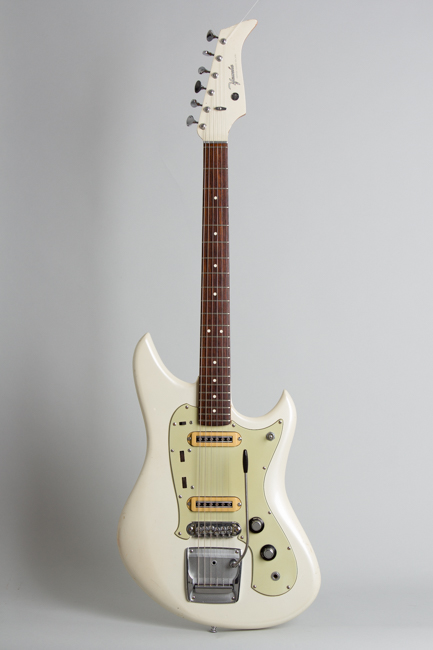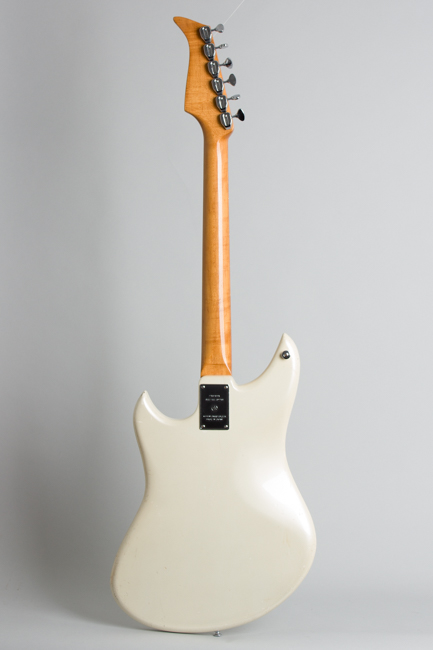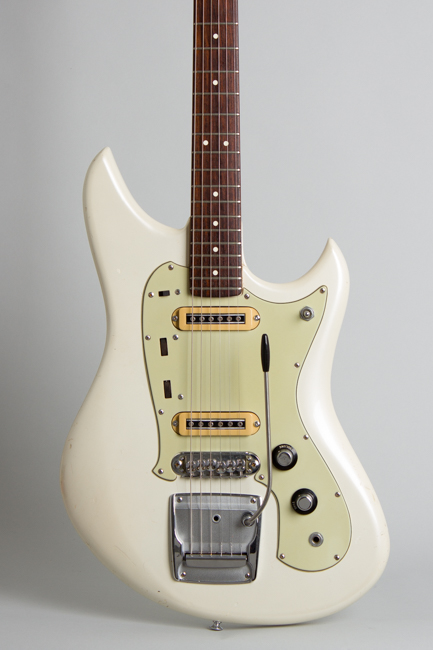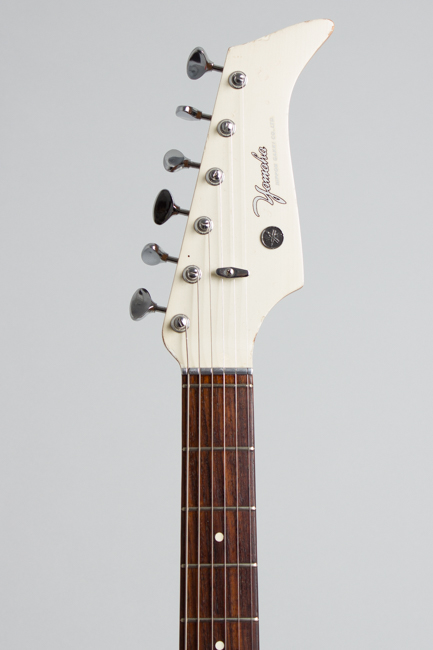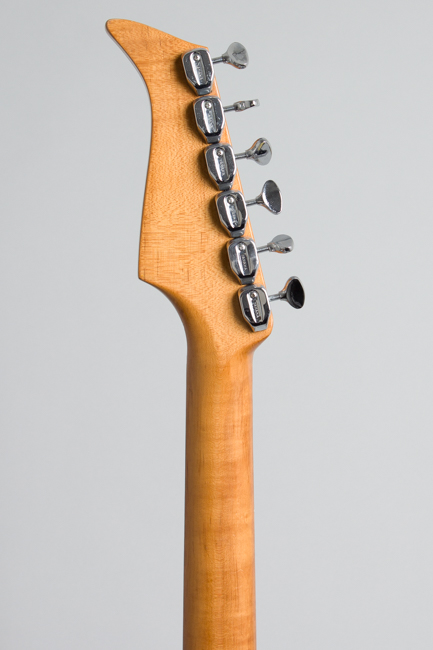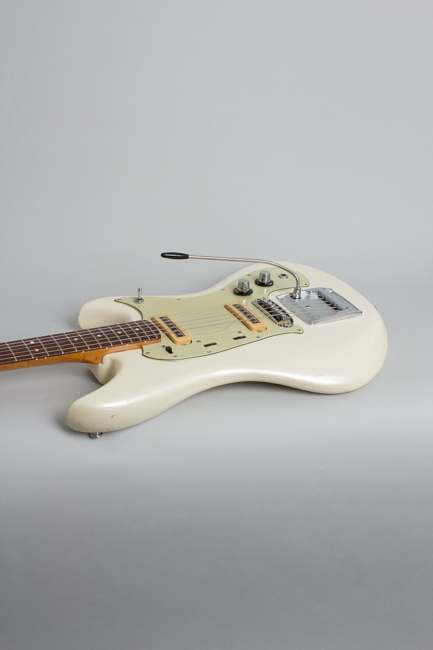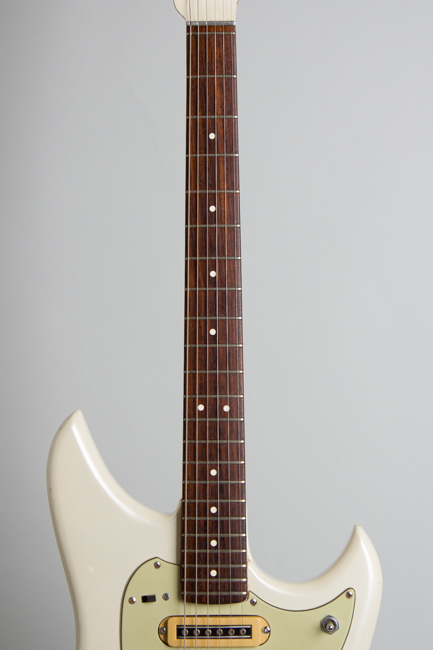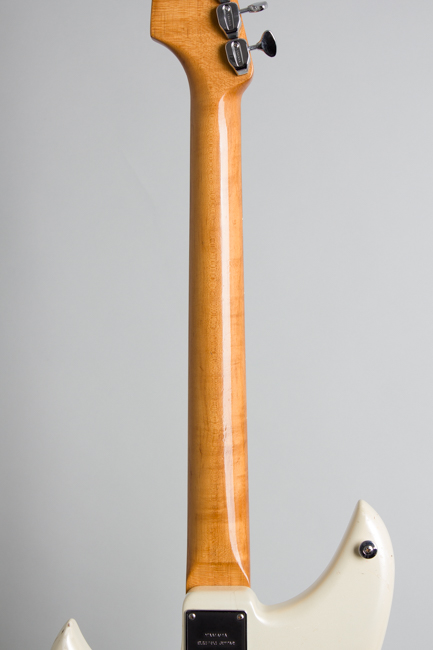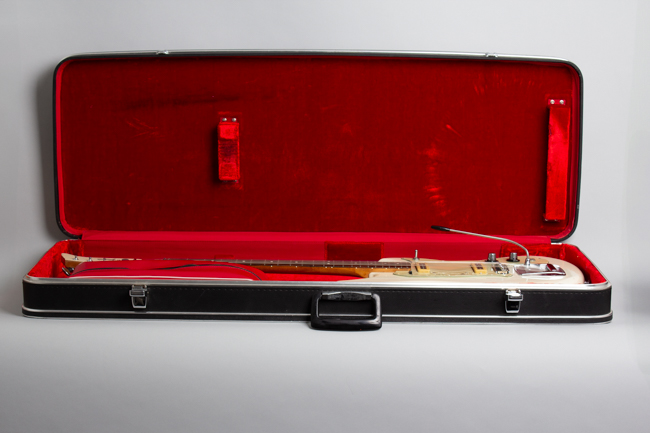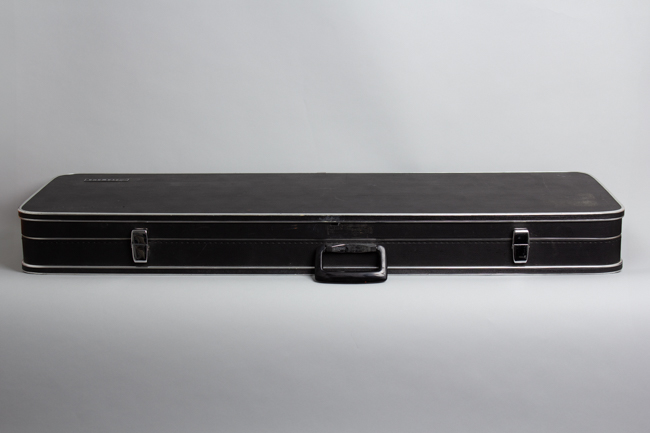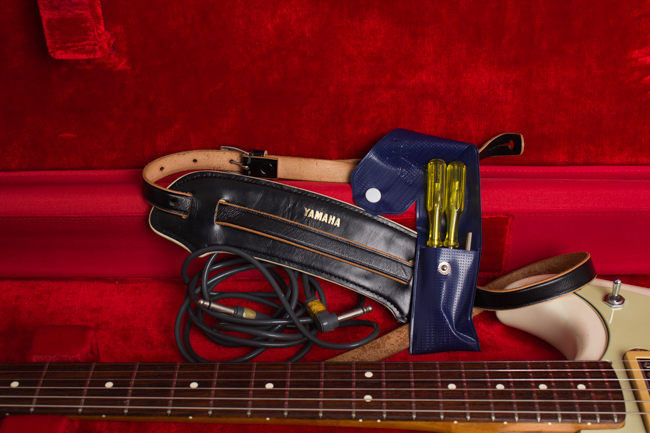Yamaha SG-2 Solid Body Electric Guitar (1966)
This item has been sold.
Item # 12952
Prices subject to change without notice.
Yamaha SG-2 Model Solid Body Electric Guitar (1966), made in Hamamatsu, Japan, serial # 2895, Pearl White finish, hardwood body, maple neck with rosewood fingerboard, original black hard shell case.
This striking angular Yamaha SG-2 is best remembered as the "Link Wray" model, although this one is in a different finish than his; a beautiful Pearl White instead of red. Wray played his Yamaha from the late 1960s intermittently up through the end of his life, and nicknamed it "Screaming Red". We don't have a nickname for this one yet, but it is a wicked little guitar.
Introduced in 1966, Yamaha's SG-2 and -3 use more conventional body and headstock shapes than the "Flying Samurai" SG-5 and 7 but still have a dramatic visual presence and are built to the same quality level. This instrument maintains a seriously higher design and construction standard than pretty much any other Japanese electrics from this period, many of which were spotty at best. Yamaha was a highly diversified company but a proud one; all of their products manifested a commitment to quality and the highest grade workmanship.
The SG-2 aesthetic borrows most heavily from the Fender Jazzmaster and Jaguar, with a whiff of Mosrite and a purely Yamaha angular twist thrown in. The dramatically offset, contoured body has sharp pointed cutaway bouts, the face covered with a pickguard that looks like a cross between a Jazzmaster and a Coral Hornet. The floating vibrato is also Jazzmaster derived, but with a screwed-to-the-body roller-saddle bridge much solider than Leo's design that actually works very well. Color options were sunburst, red and white; this one sports a very nicely done Pearl White finish.
The slim 25 1/4" scale neck has a deeper more Fender-y feel than many Mosrite-influenced Japanese designs, with almost a slight "V" contour. It does ape Semie's metal nut, zero fret and serial number stamped into the unbound rosewood fingerboard. The truss rod adjustment is hidden under the plate on the back of the heel, an idea poached from Burns guitars. The wildly pointy headstock is finished to match the body, carrying proprietary closed back Yamaha tuning machines. This early version has a cool script motorcycle-style logo and Yamaha emblem on the face.
The single-coil pickups with adjustable poles are far superior to most Japanese units of the period, controlled by a wiring circuit lifted directly from the Jazzmaster. The lower controls are a standard 1-switch, 2-knob rig, while the upper switch and recessed lateral knobs are a rhythm circuit working only on the neck pickup. For some reason the volume is backwards from Fender practice!
The SG-2 and -3 were not commonly sold in the US market, so this is a relatively rare guitar here. The entire original Yamaha SG line was discontinued by 1971, replaced by a line of well-crafted but far more conventional guitars with none of its angular flashy style. Make no mistake, this is a serious instrument at least equal to many European and even American guitars of the era. It is an excellent player and especially in this finish a really cool find.
Overall length is 41 1/2 in. (105.4 cm.), 14 in. (35.6 cm.) wide at lower bout, and 1 5/8 in. (4.1 cm.) in depth, measured at side of rim. Scale length is 25 1/4 in. (641 mm.). Width of nut is 1 5/8 in. (41 mm.).
This is a nicely all original guitar, showing some general wear to the finish but looking not too heavily played over nearly 60 years. This is a particularly cool find for the relative rarity of this model, which has its own fan following primarily due to the Link Wray connection. The all-original white lacquer finish has dings, scratches, dents and minor chipping overall, but mostly not through to the wood, just the white undercoat. There are chips down to the wood on the tip of the lower body horn and the headstock, and an errant glue spot on the headstock face from someone re-gluing the metal nut.
All fittings remain original, complete and comparatively clean, even the original trem arm is present. The rosewood fret board and original thin frets show only minimal wear. This is a great playing and sounding example of this Japanese masterwork, not often encountered on this side of the Pacific. It resides in the original rectangular black hard case with the distinctive vinyl accessories pouch containing the original Yamaha branded strap and toolkit, and the period cord. The neck rest in the case was cracked and repaired but remains solid. Overall Excellent - Condition.
This striking angular Yamaha SG-2 is best remembered as the "Link Wray" model, although this one is in a different finish than his; a beautiful Pearl White instead of red. Wray played his Yamaha from the late 1960s intermittently up through the end of his life, and nicknamed it "Screaming Red". We don't have a nickname for this one yet, but it is a wicked little guitar.
Introduced in 1966, Yamaha's SG-2 and -3 use more conventional body and headstock shapes than the "Flying Samurai" SG-5 and 7 but still have a dramatic visual presence and are built to the same quality level. This instrument maintains a seriously higher design and construction standard than pretty much any other Japanese electrics from this period, many of which were spotty at best. Yamaha was a highly diversified company but a proud one; all of their products manifested a commitment to quality and the highest grade workmanship.
The SG-2 aesthetic borrows most heavily from the Fender Jazzmaster and Jaguar, with a whiff of Mosrite and a purely Yamaha angular twist thrown in. The dramatically offset, contoured body has sharp pointed cutaway bouts, the face covered with a pickguard that looks like a cross between a Jazzmaster and a Coral Hornet. The floating vibrato is also Jazzmaster derived, but with a screwed-to-the-body roller-saddle bridge much solider than Leo's design that actually works very well. Color options were sunburst, red and white; this one sports a very nicely done Pearl White finish.
The slim 25 1/4" scale neck has a deeper more Fender-y feel than many Mosrite-influenced Japanese designs, with almost a slight "V" contour. It does ape Semie's metal nut, zero fret and serial number stamped into the unbound rosewood fingerboard. The truss rod adjustment is hidden under the plate on the back of the heel, an idea poached from Burns guitars. The wildly pointy headstock is finished to match the body, carrying proprietary closed back Yamaha tuning machines. This early version has a cool script motorcycle-style logo and Yamaha emblem on the face.
The single-coil pickups with adjustable poles are far superior to most Japanese units of the period, controlled by a wiring circuit lifted directly from the Jazzmaster. The lower controls are a standard 1-switch, 2-knob rig, while the upper switch and recessed lateral knobs are a rhythm circuit working only on the neck pickup. For some reason the volume is backwards from Fender practice!
The SG-2 and -3 were not commonly sold in the US market, so this is a relatively rare guitar here. The entire original Yamaha SG line was discontinued by 1971, replaced by a line of well-crafted but far more conventional guitars with none of its angular flashy style. Make no mistake, this is a serious instrument at least equal to many European and even American guitars of the era. It is an excellent player and especially in this finish a really cool find.
Overall length is 41 1/2 in. (105.4 cm.), 14 in. (35.6 cm.) wide at lower bout, and 1 5/8 in. (4.1 cm.) in depth, measured at side of rim. Scale length is 25 1/4 in. (641 mm.). Width of nut is 1 5/8 in. (41 mm.).
This is a nicely all original guitar, showing some general wear to the finish but looking not too heavily played over nearly 60 years. This is a particularly cool find for the relative rarity of this model, which has its own fan following primarily due to the Link Wray connection. The all-original white lacquer finish has dings, scratches, dents and minor chipping overall, but mostly not through to the wood, just the white undercoat. There are chips down to the wood on the tip of the lower body horn and the headstock, and an errant glue spot on the headstock face from someone re-gluing the metal nut.
All fittings remain original, complete and comparatively clean, even the original trem arm is present. The rosewood fret board and original thin frets show only minimal wear. This is a great playing and sounding example of this Japanese masterwork, not often encountered on this side of the Pacific. It resides in the original rectangular black hard case with the distinctive vinyl accessories pouch containing the original Yamaha branded strap and toolkit, and the period cord. The neck rest in the case was cracked and repaired but remains solid. Overall Excellent - Condition.
